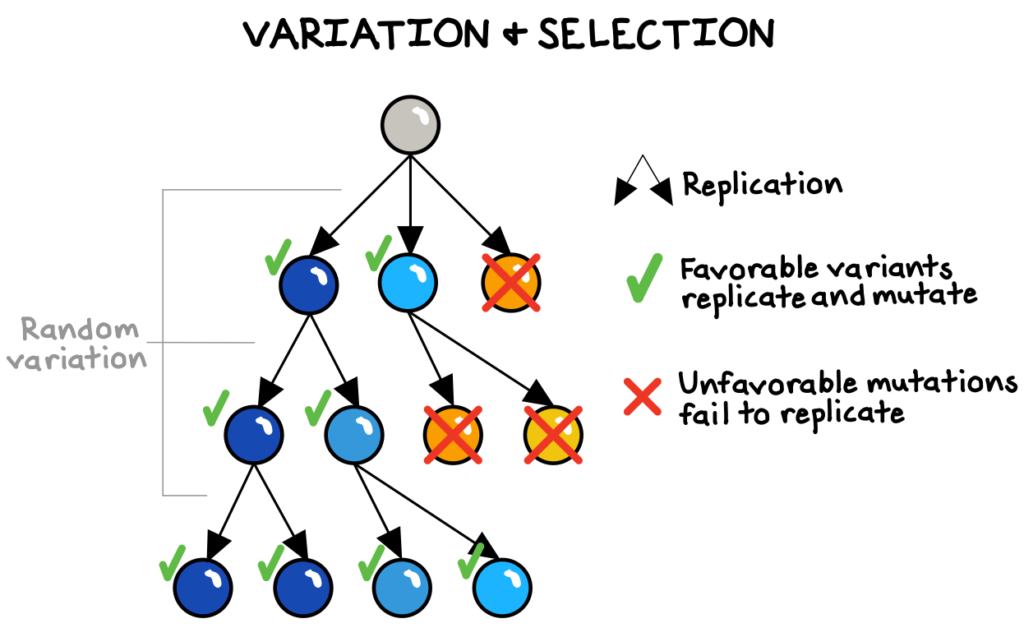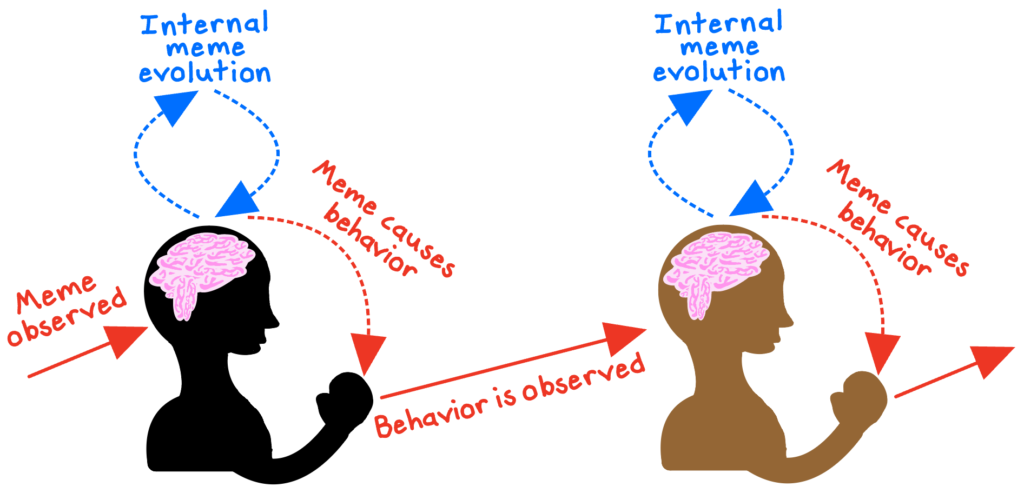“In reality, a substantial proportion of all evolution on our planet to date has occurred in human brains. And it has barely begun. The whole of biological evolution was but a preface to the main history of evolution, the evolution of memes.”
David Deutsch, The Beginning of Infinity (2011, pg. 380)
Memes are ideas that are replicators, the broader term for any entities capable of causing themselves to be copied. These aren’t limited to funny internet posts. Memes could include jokes, languages, cultural traditions, artistic movements, business strategies, advertising jingles, scientific theories, conspiracy theories, religions, documents, or recipes. Each of these ideas contains (often inexplicit) knowledge for causing its own propagation across human minds, through an evolutionary process of creation and recreation.1
The leaders who transform political, social, scientific, or corporate systems—for better or worse—share the ability to successfully spread their ideas to others. Indeed, all human progress (and suffering) has relied on the creation and replication of memes—including those underlying democracy and autocracy, science and dogma, morality and evil.
For those striving to become more effective strategists and decision makers, fluency with memetics (the study of memes) better equips us to recognize and cultivate good ideas—and, more importantly, to avoid bad ones.
Genetic vs. memetic evolution
An enlightening way to explore memes is by contrast to the original replicators: genes, the bits of DNA that are copied across generations in living organisms.
Genes are the basis of biological evolution, which occurs through the imperfect copying of genes from parents to offspring, followed by a “selection” process in which nature ruthlessly filters out the gene variants that are less successful at causing their own replication.

Through 600m years of evolution, these remarkable molecules have given rise to the complex systems of control and feedback we see throughout nature in plants, animals, and bacteria. Genetic evolution, however, is slow—operating on timescales far too long for us to notice.
Memes—a concept coined by biologist Richard Dawkins and elucidated by physicist David Deutsch—also operate through replication, variation, and selection. First, someone transmits a meme (a joke, theory, recipe) to someone else. The recipient then either reenacts a version of that meme to others, or not. If its new holders recreate the meme, they may introduce further variations. “Selection” takes place as the competing “meme variants” achieve differential success in causing their own replication.
Here, however, the meme-gene metaphor crumbles. Whereas genes mutate randomly, with no regard to what problems they might solve, we can create new memes with conscious foresight. Moreover, memes undergo random and intentional variation not only when we express them to others, but also within our own minds. Our creative faculties enable us to subject our ideas to thousands of cycles of variation and selection before we ever enact a variant! Finally, we can transmit a meme immediately, and to anyone, not just our children. For these reasons, meme evolution is exponentially faster than gene evolution.2

We can create, vary, and discard our ideas with remarkable speed. This ability, in fact, helps explain the “ascent of man,” and especially our accelerating technological progress in the ~400 years since the Enlightenment. Our knowledge growth is no longer bound by genetic timescales.
How ideas spread
But why do some memes flourish, while most perish? Unfortunately, as with genes, the memes that survive don’t necessarily need to be “good,” or even beneficial. They simply must be better at displacing competing memes from the population of ideas.
Memes successfully replicate through one of two basic strategies: (1) by helping their holders (rational memes), or (2) by inhibiting their holders’ critical abilities (anti-rational memes).3
1) Rational memes
Memes can help their holders solve problems by conferring useful knowledge, such as the recipe to create bread, the knowledge of how to raise a child, instructions for constructing shelter, or a good scientific theory like Einstein’s theory of relativity. Because rational memes like these undergo countless cycles of creative variation and critical selection, they evolve to become increasingly useful. They prevail over alternative memes not because they have been immune from criticism, but because they withstood criticism and evolved accordingly. Memetics itself is robustly criticized4—as it should be.

Rational memes thrive in open, dynamic societies and organizations—where people can freely critique, vary, and discard them.
2) Anti-rational memes
Memes that can’t withstand rational scrutiny may still spread by incorporating knowledge to prevent such scrutiny in the first place. These anti-rational memes include a myriad of ideologies and dangerous yet contagious ideas, such as conspiracy theories, autocracy, crackpot religions, and discriminatory or violent cultural beliefs. These memes propagate not by being more useful, but by successfully shielding themselves from criticism.

For instance, conspiracy theories shouldn’t survive long after the factual evidence inevitably contradicts them, so they struggle to spread on their own. They almost always include an additional theory: that the conspirators and the news media are “in” on the conspiracy together—so you can’t trust any information from either of them!5 This anti-rational “protective coating” discourages holders of the conspiracy meme from taking any contradictory evidence seriously.
Consider also the case of North Korea, a one-party state led by a totalitarian dictatorship. The legitimacy of the Kim dynasty rests on an intricate system of anti-rational memes and illiberal policies that suppress criticism and dissent, including “divine right,” mass surveillance, arbitrary arrests, torture camps, rigged elections, political punishments, and state-run media.6 The result is a wholly static society that compares miserably to its free and democratic neighbor, South Korea.
Though North and South Korea possess similar natural resources and share the same ethnic makeup and language, the lives of their citizens could not be more different. South Koreans enjoy a robust democracy, strong civil liberties, and average incomes nearly 30x higher than their Northern neighbors. Meanwhile, North Koreans suffer from inexcusably high rates of poverty, corruption, starvation, disease, and infant mortality.
Rational meme organizations
It is not just governments, but all institutions that should be evaluated based on how well they facilitate error-correction—companies included. Creating dynamic, durable organizations requires that rational memes can evolve without anti-rational memes suffocating change.
Such organizations must cultivate three key traits: (1) criticism, (2) experimentation, and (3) information-sharing.
- Criticism — When a leader’s authority rests on suppressing criticism, errors will go uncorrected, and stagnancy and decay are inevitable. This is one reason why the modern “board governance” corporate structure evolved: the board of directors acts as an error-correction mechanism that can remove incompetent leaders. Beware any institution in which individuals have unconstrained power or cultivate an environment in which criticizing or questioning them is unsafe. A great positive example is Netflix, which has institutionalized guiding principles for open, frequent feedback and even disagreement—not just with peers and subordinates, but with senior management.7 Netflix’s dynamic “feedback culture” enables employees to promptly address errors and improve themselves.
- Experimentation — Every organization must balance efforts to exploit its current businesses and memes with experiments to explore new ones. Unfortunately, when the environment feels stable, many large organizations stop experimenting because it seems costly and inefficient.8 Such complacency is a death sentence in dynamic competitive environments. Consider ChatGPT-maker OpenAI, who promotes experimentation using a unique approach that embeds researchers directly into product teams, shortening the feedback loop between ideation and development.9
- Information-sharing — Companies with a culture of transparency and documentation facilitate criticism and improvement of their memes. For rational memes to evolve efficiently, information and ideas should be codified in shareable, collaborative documents. Amazon is the paragon here. All meetings start with a pre-read of a standardized document format that summarizes an idea, an analysis, or a potential solution to a problem.10 This practice facilitates shared understanding, promotes diverse input and criticism of ideas, and creates an easily replicable artifact for every meeting and decision.
***
When we die, we leave behind genes and memes. In a couple generations, our genes will be forgotten. Memes, however, can live on.
Culturally, professionally, and politically, we should ask ourselves what memes we are creating, spreading, and allowing into our minds. Do they foster progress and understanding? Have we adequately considered alternatives? Are they somehow shielded from criticism by ourselves or others?
If we find ways to contribute positive ideas, behaviors, and culture to the world, we may leave a memetic legacy that long outlives our genes.
Notes
- Deutsch, D. (2011). The Beginning of Infinity. Penguin Books. 378-380.
- Deutsch, D. (2011). 372-380.
- Deutsch, D. (2011). 388-390.
- See Burman (2012).
- Ellenberg, J. (2015). How Not to Be Wrong. The Penguin Press. 183-184.
- North Korea Country Report. (2023). Freedom House.
- WeAreNetflix (2021, July 27). Feedback at Netflix [Video]. WeAreNetflix Podcast.
- Beinhocker, E. (January 1999). On the origin of strategies. The McKinsey Quarterly, 4(4), 169-173.
- Orosz, G. (2023, November 14). Inside OpenAI. The Pragmatic Engineer.
- Garrison, J. (2021, March 15). The Document Culture of Amazon.

